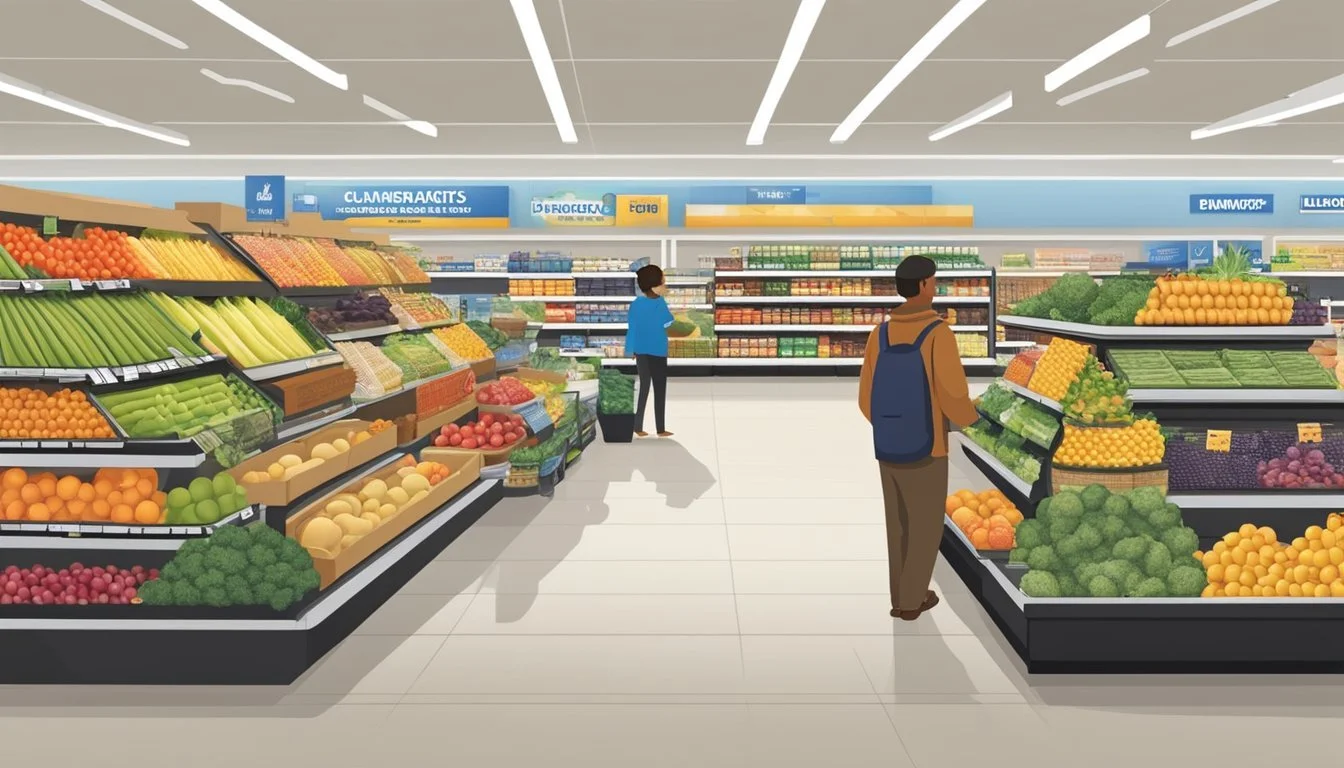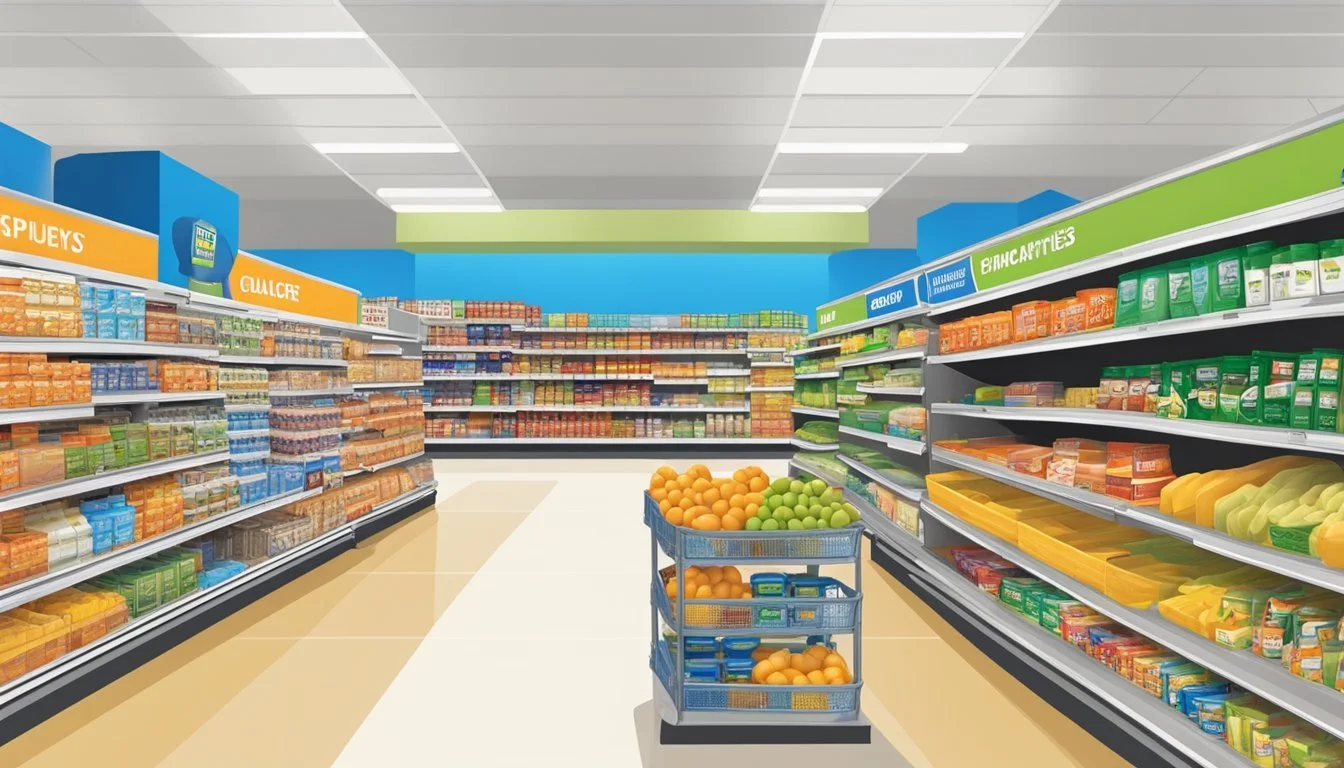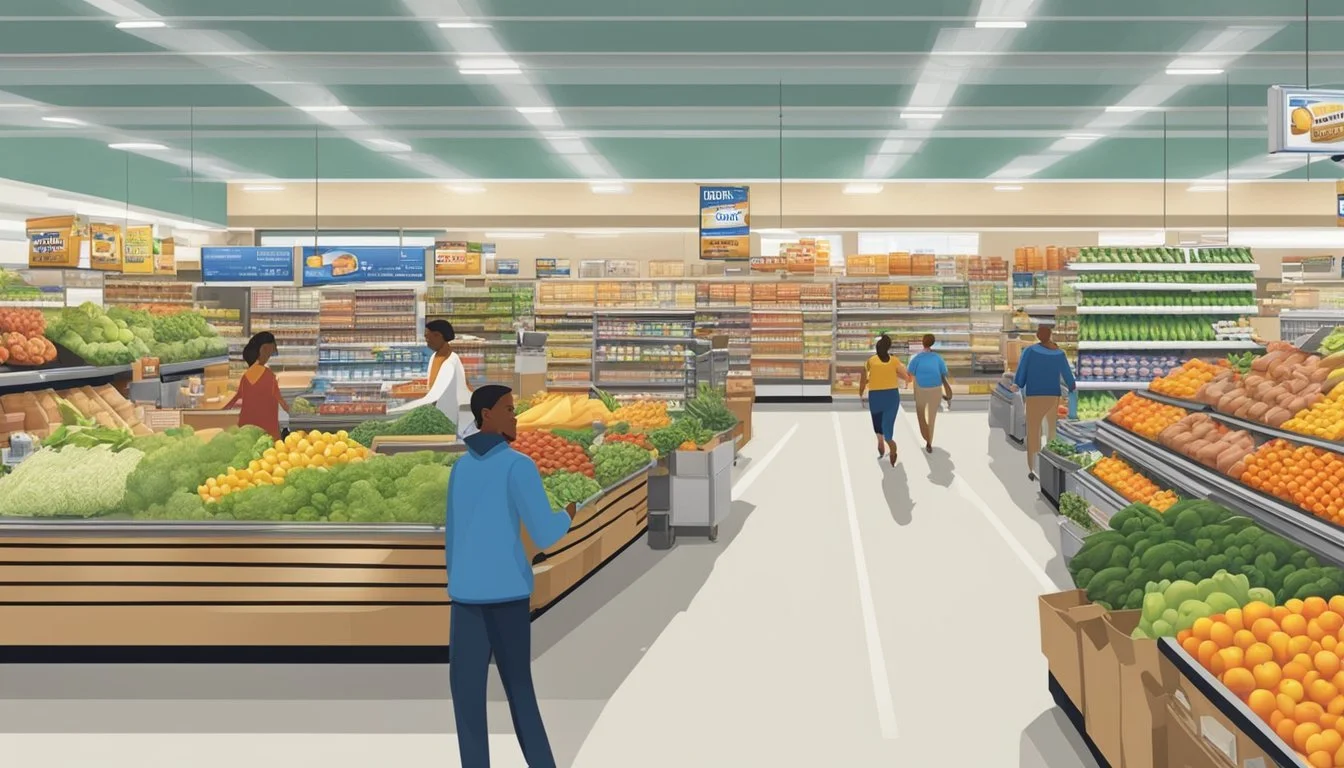Food Lion vs Walmart
A Comprehensive Comparison of Prices, Quality, and Selection
When it comes to grocery shopping, two major players often come to mind: Food Lion and Walmart. These retail giants have carved out significant niches in the American grocery landscape, each offering unique advantages to consumers.
Food Lion, with over 1,000 stores across 10 states, focuses on providing quality fresh produce, meats, and dairy products at competitive prices. The company's emphasis on local sourcing and frequent promotions has earned it a loyal customer base. Compared to average prices at surveyed stores, Food Lion's prices were found to be 12% lower, making it a strong contender for budget-conscious shoppers.
Walmart, on the other hand, boasts a massive nationwide presence and a reputation for consistently low prices across a wide range of products. As the world's largest retailer, Walmart leverages its size to offer groceries at prices that are often 16% below the average of surveyed stores. This pricing strategy, combined with the convenience of one-stop shopping for both groceries and general merchandise, attracts millions of customers daily.
Company Overviews
Food Lion and Walmart have distinct histories and growth trajectories. Both have expanded their presence significantly over the years, becoming major players in the grocery retail industry.
History and Expansion of Food Lion
Food Lion began as Food Town in 1957 in Salisbury, North Carolina. The company rebranded to Food Lion in 1983 to facilitate expansion. Food Lion grew rapidly in the 1980s and 1990s, focusing on the Southeast and Mid-Atlantic regions.
By 2024, Food Lion operates approximately 1,100 stores across 10 states. The chain is known for its focus on low prices and convenient locations. Food Lion has adapted to changing consumer preferences by introducing organic options and enhancing its digital presence.
The company has faced challenges, including a highly publicized food safety scandal in the 1990s. However, Food Lion rebounded through store renovations and improved practices.
History and Expansion of Walmart
Walmart was founded by Sam Walton in 1962 in Rogers, Arkansas. The company's growth strategy centered on offering low prices and expanding into rural areas often overlooked by other retailers.
Walmart went public in 1970 and experienced explosive growth. By 1990, it had become the largest retailer in the United States. The company introduced its Supercenter format in 1988, combining general merchandise with full grocery departments.
Walmart's international expansion began in 1991 with a store in Mexico. Today, Walmart operates in 24 countries under various banners. The company has over 10,500 stores worldwide, with about 4,700 in the United States.
Walmart has also invested heavily in e-commerce, acquiring Jet.com in 2016 and expanding its online grocery services. The company continues to innovate with initiatives like drone delivery and automated fulfillment centers.
Product Selection and Quality
Walmart and Food Lion offer distinct product selections and quality levels across their grocery departments. Both chains aim to meet diverse customer needs, but with differing approaches to variety, freshness, and pricing.
Comparison of Produce Quality
Walmart typically stocks a wide range of fruits and vegetables, including organic options. Their produce section often features pre-packaged salads and cut fruits for convenience. Food Lion, while offering a smaller produce selection, focuses on regional and seasonal items.
Walmart's produce quality can vary between locations, with some customers reporting inconsistent freshness. Food Lion generally maintains a reputation for fresher produce, especially in their local and seasonal offerings.
Both stores implement quality control measures, but Food Lion's smaller scale allows for more frequent restocking and rotation of perishable items.
Diversity in Available Brands
Walmart boasts an extensive array of national brands alongside its Great Value store brand. This variety spans across most grocery categories, giving customers numerous options at different price points.
Food Lion offers a more curated selection of national brands but places greater emphasis on its My Essentials and Nature's Promise private labels. These store brands are often competitively priced against national equivalents.
Walmart's size allows it to stock niche and specialty brands that may not be available at Food Lion. However, Food Lion tends to feature more regional brands that cater to local tastes.
Meat and Deli Offerings
Walmart's meat department provides a broad selection of pre-packaged meats, including value packs and organic options. Their deli counters offer sliced meats and cheeses, along with prepared foods and rotisserie chickens.
Food Lion focuses on quality in its meat section, often featuring locally sourced options and specialty cuts. Their delis typically offer a smaller but well-curated selection of meats and cheeses, with an emphasis on freshness.
Both stores provide basic marinated meats and seasoned options, but Food Lion may have an edge in custom cuts and personalized service at the meat counter.
Dairy and Bread
Walmart's dairy section is extensive, featuring numerous national brands and Great Value alternatives for milk, cheese, yogurt, and eggs. Their bread aisle includes a wide variety of sliced breads, rolls, and specialty items.
Food Lion's dairy offerings, while more limited, often include local and regional brands alongside national options. Their bread selection tends to focus on staple items with a mix of store brand and popular national brands.
Both chains stock organic and specialty dairy products, but Walmart typically offers a wider range of alternative milk options. Food Lion may have an advantage in featuring artisanal and locally baked breads in some locations.
Pricing and Savings
Walmart and Food Lion employ different strategies to offer value to shoppers. Their approaches to pricing, promotions, and customer loyalty programs can significantly impact grocery budgets.
Everyday Price Comparison
Walmart's "Everyday Low Prices" strategy aims to consistently offer competitive rates across its product range. Food Lion, in contrast, focuses on providing low prices on essential items. A recent comparison of 38 common grocery items revealed Walmart to be slightly cheaper overall, with a total of $86.37 compared to Food Lion's $88.31.
Walmart's bulk purchasing power often allows for lower prices on national brands. Food Lion, however, may offer better deals on fresh produce, dairy, and meats.
Shoppers should compare prices on their most frequently purchased items to determine which store aligns best with their needs.
Discounts and Promotions
Both retailers offer various discounts and promotions to attract customers. Food Lion runs weekly specials and "Hot Sale" items, which can provide significant savings on select products. Their MVP Card unlocks additional discounts.
Walmart features rollback prices and clearance items throughout the store. They also offer a "Savings Catcher" program, which refunds the difference if a local competitor advertises a lower price on eligible items.
Seasonal promotions are common at both stores, with holiday-themed discounts and back-to-school savings events.
Loyalty Programs and Benefits
Food Lion's MVP Card is free to join and offers personalized coupons, exclusive discounts, and the ability to earn "Shop & Earn" rewards. These rewards can be redeemed for savings on future purchases.
Walmart+ is a paid membership program that provides benefits such as free delivery, fuel discounts, and early access to special promotions. It costs $98 annually or $12.95 monthly.
Both programs aim to increase customer loyalty and provide added value, but their structures differ significantly. Food Lion's program is more accessible, while Walmart+ offers broader benefits for frequent shoppers.
Price Match and Adjustment Policies
Walmart's price matching policy is more comprehensive than Food Lion's. Walmart will match prices from select online retailers and local competitors on identical, in-stock items. They also offer a 14-day price adjustment on recent purchases if the price drops.
Food Lion has a more limited price matching policy, typically only matching prices on advertised items from local competitors. They do not have a formal price adjustment policy for past purchases.
These policies can lead to additional savings for savvy shoppers who monitor prices and competitors' ads. Walmart's broader policy may appeal to those who prioritize getting the lowest possible price on every item.
Store Layout and Shopping Experience
Food Lion and Walmart offer distinct shopping environments, each with its own approach to store layout, services, and customer experience. These differences impact how shoppers navigate the stores and access various amenities.
Ease of Navigation
Food Lion typically features a more compact layout, making it easier for shoppers to quickly find what they need. Aisles are often shorter and more clearly labeled. Walmart, with its larger footprint, can be more challenging to navigate. However, Walmart's wider aisles accommodate higher customer traffic.
Food Lion organizes products in a logical manner, with similar items grouped together. This arrangement helps customers complete their shopping efficiently. Walmart's vast selection sometimes leads to products being spread across multiple sections, which can increase shopping time.
Both stores use clear signage, but Food Lion's smaller size gives it an edge in terms of quick trips and convenience.
In-Store Services and Amenities
Walmart outshines Food Lion in the variety of in-store services offered. Many Walmart locations feature:
Vision centers
Auto service centers
Photo labs
Money centers for financial services
Food Lion focuses primarily on grocery-related services. These often include:
Deli counters
Bakery sections
Coin-counting machines
Walmart's larger stores allow for more amenities, such as in-store restaurants or banks. Food Lion, while more limited in scope, excels in providing efficient grocery-specific services.
Cleanliness and Store Maintenance
Both chains prioritize cleanliness, but execution can vary by location. Food Lion's smaller stores are often easier to maintain, resulting in a consistently tidy appearance. Shelves are typically well-stocked and organized.
Walmart's high traffic can pose challenges for maintenance teams. However, many locations have implemented rigorous cleaning schedules to address this issue. Restroom cleanliness and overall store appearance have improved in recent years.
Food Lion's focus on groceries means fewer non-food items to manage, potentially contributing to a neater store environment. Walmart's diverse inventory requires more frequent restocking and organization efforts.
Customer Satisfaction Ratings
Customer surveys indicate mixed results for both chains. Food Lion receives praise for its:
Quick checkout process
Friendly staff
Easy-to-navigate stores
Walmart garners positive feedback for its:
Wide product selection
Competitive pricing
One-stop shopping convenience
According to available data, Food Lion achieves a Knoji score of 4.3 out of 5 based on 72 ratings. This suggests generally positive customer experiences. Walmart's exact score is not provided, but consumer surveys indicate satisfaction with its broad range of products and services.
Food Lion's regional focus allows for more tailored customer service, potentially contributing to higher satisfaction in its operating areas. Walmart's nationwide presence means experiences can vary widely between locations.
Additional Offerings
Walmart and Food Lion provide more than just groceries to meet diverse customer needs. Both retailers have expanded their product ranges and services to offer convenience and value beyond traditional grocery items.
Non-Grocery Product Availability
Walmart boasts an extensive selection of non-grocery items. The retail giant stocks electronics, clothing, home goods, and automotive supplies. Customers can purchase televisions, smartphones, and laptops alongside their groceries.
Food Lion's non-grocery offerings are more limited. The chain focuses primarily on household essentials and seasonal items. Shoppers can find cleaning supplies, kitchenware, and basic health and beauty products.
Walmart's broader range makes it a one-stop shop for many consumers. Food Lion, while more limited, still provides necessary non-food items for quick purchases during grocery trips.
Prepared Foods and To-Go Options
Both stores offer prepared foods, but with different approaches. Walmart features a deli section with hot foods, rotisserie chickens, and pre-made salads. Many locations include in-store restaurants like Subway or McDonald's.
Food Lion's prepared food options are typically smaller in scale. The chain offers rotisserie chickens, pre-made sandwiches, and a selection of grab-and-go meals. Some stores have hot food bars with daily specials.
Walmart's larger stores often provide more variety in prepared foods. Food Lion's offerings, while more limited, focus on quick meal solutions for busy shoppers.
Online Shopping and Digital Coupons
Walmart has invested heavily in e-commerce. The company offers grocery pickup and delivery services through its website and app. Digital coupons are easily accessible and can be applied to online orders.
Food Lion has also embraced digital solutions. The chain provides online ordering for pickup at select locations. Their app features digital coupons and a virtual loyalty card for in-store savings.
Both retailers offer digital weekly ads. Walmart's online platform is more robust, with a wider range of products available for purchase. Food Lion's digital offerings focus primarily on groceries and household essentials.
Strategic Position and Market Segment
Walmart and Food Lion occupy distinct positions in the grocery retail landscape, targeting different consumer segments and employing varied strategies to compete in the market.
Target Demographics and Regional Focus
Walmart caters to a broad demographic, appealing to budget-conscious shoppers across the United States. Its vast network of stores serves both urban and rural areas, offering a one-stop shopping experience for groceries and general merchandise.
Food Lion, in contrast, focuses primarily on the Mid-Atlantic and Southeastern regions. It targets local communities with a more intimate shopping experience. Food Lion's strategy emphasizes serving area consumers with convenient locations and competitive pricing.
Comparison with Competing Chains
Walmart faces competition from diverse retailers like Amazon, Target, and Whole Foods. Its main advantage lies in its extensive product range and low prices.
Food Lion competes directly with regional chains such as Giant, Harris Teeter, and Safeway. It also contends with discount grocers like Aldi and Lidl. Food Lion's competitive edge stems from its neighborhood presence and tailored local offerings.
Both chains must adapt to the growing threat from online retailers and the increasing popularity of grocery delivery services.
In-Depth Market Analysis
Walmart holds a significant market share in the U.S. grocery sector, with its size allowing for economies of scale and bargaining power with suppliers. This enables Walmart to maintain its everyday low price strategy.
Food Lion, while smaller, has carved out a strong niche in its core markets. Its focus on fresh produce and private label products appeals to cost-conscious consumers seeking quality at affordable prices.
Market trends show increasing consumer demand for convenience, healthier options, and sustainable practices. Both Walmart and Food Lion are adapting their strategies to meet these evolving preferences, investing in online ordering, curbside pickup, and expanding organic product lines.
Conclusion
Food Lion and Walmart both offer distinct advantages for grocery shoppers. Food Lion excels in providing fresh produce and a more personalized shopping experience. Its smaller stores can be more convenient for quick trips.
Walmart, on the other hand, boasts a wider selection of products and generally lower prices across the board. The retail giant's large supercenters allow for one-stop shopping, saving time for busy families.
Budget-conscious consumers may find better overall savings at Walmart. However, Food Lion's loyalty program and targeted promotions can result in significant discounts for regular shoppers.
Health-conscious individuals might prefer Food Lion's emphasis on fresh, local produce. Walmart's extensive organic options and low prices on staples can also appeal to those seeking nutritious choices.
Researchers have found that customer service experiences vary between the two chains. Food Lion often receives higher marks in this area.
Ultimately, the choice between Food Lion and Walmart depends on individual priorities. Shoppers should consider factors such as price, product range, store location, and shopping preferences when deciding where to buy groceries.




